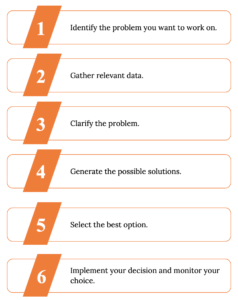7.10 Decision Making Skills
Adapted by Stephen Skripak with Ron Poff
Decision-Making Skills
Every manager is expected to make decisions, whether alone or as part of a team. Drawing on your is often a process in which you must define a problem, analyze possible solutions, and select the best outcome. As luck would have it, because the same process is good for making personal decisions, we’ll use a personal example to demonstrate the process approach to decision making. Consider the following scenario: you’re upset because your midterm grades are much lower than you’d hoped. To make matters worse, not only are you in trouble academically, but also the other members of your business-project team are annoyed because you’re not pulling your weight. Your lacrosse coach is very upset because you’ve missed too many practices, and members of the mountain-biking club of which you’re supposed to be president are talking about impeaching you if you don’t show up at the next meeting. And your significant other is feeling ignored.
A Six-Step Approach to Decision Making
Assuming that your top priority is salvaging your GPA, let’s tackle your problem by using a six-step approach to solving problems that don’t have simple solutions. We’ve summarized this model in Figure 7.8[1]

Identify the problem you want to work on
Step one is getting to know your problem, which you can formulate by asking yourself a basic question: how can I improve my grades?
Gather relevant data
Step two is gathering information that will shed light on the problem. Let’s rehash some of the relevant information that you’ve already identified: (a)you did poorly on your finals because you didn’t spend enough time studying; (b) you didn’t study because you went to see your girlfriend (who lives about three hours from campus) over the weekend before your exams (and on most other weekends, as a matter of fact); (c) what little studying you got in came at the expense of your team project and lacrosse practice; and (d) while you were away for the weekend, you forgot to tell members of the mountain-biking club that you had to cancel the planned meeting.
Clarify the problem
Once you review all the given facts, you should see that your problem is bigger than simply getting your grades up; your life is pretty much out of control. You can’t handle everything to which you’ve committed yourself. Something has to give. You clarify the problem by summing it up with another basic question: what can I do to get my life back in order?
Generate possible solutions
Let’s say that you’ve come up with the following possible solutions to your problem: (a) quit the lacrosse team, (b) step down as president of the mountain-biking club, (c) let team members do your share of work on the business project, and (d) stop visiting your significant other so frequently. The solution to your main problem—how to get your life back in order—will probably require multiple actions.
Select the best option
This is clearly the toughest part of the process. Working your way through your various options, you arrive at the following conclusions: (a) you can’t quit the lacrosse team because you’d lose your scholarship; (b) you can resign your post in the mountain-biking club, but that won’t free up much time; (c) you can’t let your business-project team down (and besides, you’d just get a low grade); and (d) she wouldn’t like the idea, but you could visit your girlfriend, say, once a month rather than once a week. So what’s the most feasible (if not necessarily perfect) solution? Probably visiting your significant other once a month and giving up the presidency of the mountain-biking club.
Implement your decision and monitor your choice
When you call your girlfriend, you’re pleasantly surprised to find that she understands. The vice president is happy to take over the mountain-biking club. After the first week, you’re able to attend lacrosse practice, get caught up on your team business project, and catch up in all your other classes. The real test of your solution will be the results of the semester’s finals.
Key Takeaways
- Managers need to have excellent decision making skills in order to succeed
- Decision-making tools, like the process described above, can help managers to make better decisions
- Shari Caudron (1998). “Six Steps in Creative Problem Solving.” Controller Magazine. p. 38; Caudron describes a systematic approach developed by Roger L. Firestien, president of Innovation Systems Group, Williamsville, NY. ↵
process in which you must define a problem, analyze possible solutions, and select the best outcome

